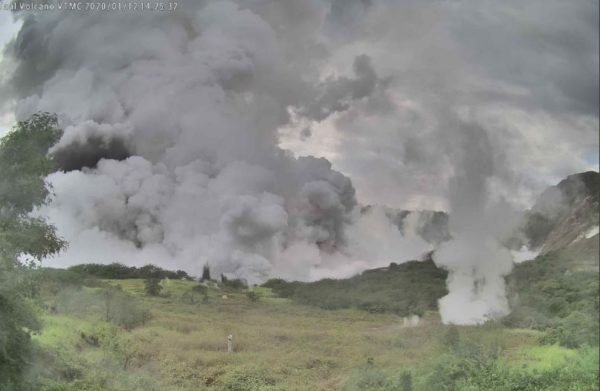Philippines: Taal Volcano Begins Spewing Lava as Hazardous Eruption is Possible Within Hours

The Philippines’ Taal volcano has begun spewing lava, as authorities warn that a “hazardous eruption” is possible “within hours or days”.
In the early hours of January 13 weak lava began flowing out of the volcano – located some 45 miles south of the capital Manila.
It comes after Taal emitted a huge plume of ash, triggering the mass evacuation of 8,000 people from the area.
Taal is the Philippines’ second most active volcano.
Situated on an island in the middle of a lake, Taal is one of the world’s smallest volcanoes and has recorded at least 34 eruptions in the past 450 years.
The Philippine Institute of Volcanology and Seismology (Phivolcs) said in a statement: “Taal volcano entered a period of intense unrest… that progressed into magmatic eruption at 02:49 to 04:28… this is characterized by weak lava fountaining accompanied by thunder and flashes of lightning.”
However, Phivolcs director Renato Solidum said that signs of a hazardous eruption, including “flows of ashes, rocks, gas at speeds of more than 60 kph horizontally” had not yet occurred, according to CNN Philippines.
Tamu Massif: World’s largest volcano discovered beneath Pacific
Supervolcanoes may form and erupt in just hundreds of years
Phivolcs has now raised the alert level from 3 to 4, out of a maximum of 5.
Authorities have also warned of a possible “volcanic tsunami”, which can be trigged by falling debris after an eruption, pushing the water and generating waves.
On January 12, the volcano emitted a giant plume of ash, with rumbling sounds and tremors also reported.
According to Phivolcs, a total of 75 earthquakes have occurred in the Taal region, with 32 of these earthquakes ranking 2 and higher on the earthquake intensity scale.
The Official United Nations Office for the Coordination of Humanitarian Affairs (OCHA) said more than 450,000 people are estimated to live within the 10 miles danger zone of the Taal volcano.
The Civil Aviation Authority announced on January 13 that it had resumed “partial operations” as of 10:00 local time for flights departing the airport and 12:00 for flights arriving.
The Philippine stock exchange also announced it would halt all trading on January 13.
President Rodrigo Duterte’s office has also ordered the suspension of government work in Manila and of all schools across all levels in the capital.

